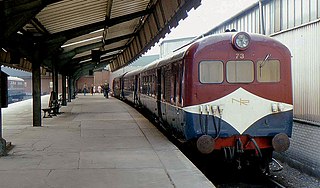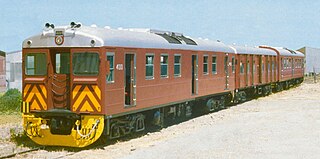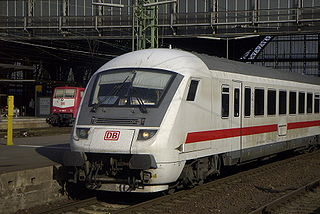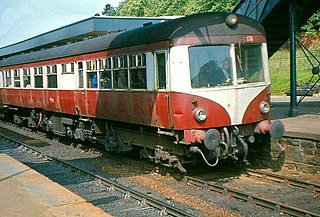
A railbus is a lightweight passenger railcar that shares many aspects of its construction with a bus, typically having a bus body and four wheels on a fixed base instead of on bogies. Originally designed and developed during the 1930s, railbuses have evolved into larger dimensions with characteristics similar in appearance to a light railcar, with the terms railcar and railbus often used interchangeably. Railbuses designed for use specifically on little-used railway lines were commonly employed in countries such as Germany, Italy, France, the United Kingdom, and Sweden.

The British Rail Classes 101 and 102 diesel-mechanical multiple units were built by Metro-Cammell at Washwood Heath in Birmingham, England from 1956 to 1959, following construction of a series of prototype units. These classes proved to be some of the most successful and longest-lived of BR's First Generation DMUs, second in longevity only to the Class 121, with the final five units being withdrawn on 24 December 2003. The oldest set was, by then, just over 47 years old.

In 1933, the Great Western Railway introduced the first of what was to become a successful series of diesel railcars, which survived in regular use into the 1960s, when they were replaced with the new British Rail "first generation" type diesel multiple units.
A wide variety of hauled coaches have been used on the railways of Ireland. This page lists all those since 1945.

The British Rail Class 126 diesel multiple unit was built by BR Swindon Works in 1959/60 to work services from Glasgow to Ayrshire and comprised 22 3-car sets and were a development of the earlier Swindon-built trainsets that had been introduced in 1955 to work the Edinburgh Waverley - Glasgow Queen St services. These vehicles formed the first Inter City service to be operated by diesel units in Great Britain.

The Ulster Transport Authority Multi-Purpose Diesel was a diesel powered railcar, used in Northern Ireland. It was developed by the Ulster Transport Authority (UTA) as a progression of the earlier Multi-engined Diesel (MED). The MED concept, while suitable for short commuter links, was not considered so for the Northern Counties Committee section, with its main line from Belfast to Derry where speeds of up to 110 km/h (70 mph) were required. A new railcar development was needed, and the MED was superseded by the MPD.

UTA 70 class was a diesel multiple unit train built for service on the Ulster Transport Authority's railway network. The MED’s and MPD’s, which made use of readily available power and transmission units, were cheap to operate but noisier and not as comfortable as locomotive-hauled rolling stock, a fact which made them unsuitable for Inter-City journeys. The decision was made to develop a new generation of multiple unit and in July 1966 the first of the new DEMU sets entered service.

The 80 Class is a type of diesel electric multiple unit formerly used by Northern Ireland Railways. They were affectionately nicknamed 'Thumpers' by rail enthusiasts due to the thumping noise their engines produced.

Following the end of World War II, most railways throughout the world were looking to either update their fleet of steam locomotives with new and more economical designs or look towards alternatives, which for many meant a programme of dieselisation. The main considerations were the rising cost of coal against diesel oil and the weight of the trains causing wear and tear on the track. In looking to the dieselisation of their system the Ulster Transport Authority (UTA) made early inroads with small, lightweight diesel units, based on those built for the Great Western Railway in England, using the same manufacturers to supply parts and undertaking construction in their own workshops.

The Great Northern Railway of Ireland (GNRI) AEC Class were Associated Equipment Company (AEC)–engined diesel multiple units that operated InterCity and suburban services on the GNRI and later Ulster Transport Authority (UTA) systems between 1950 and 1975. They were finally withdrawn in 1972. They were the inspiration for the CIÉ 2600 Class.

Redhen railcar was the nickname given to the 300 and 400 classes of diesel-hydraulic railcars designed by the South Australian Railways and built at its Islington Railway Workshops between 1955 and 1971. The railcars, which operated in Adelaide suburban service until 1996, remain a nostalgic part of South Australian memory. Some continue to be operated by the SteamRanger Heritage Railway, the National Railway Museum, Port Adelaide and other railway preservation entities.

A control car, cab car, control trailer, or driving trailer is a non-powered rail vehicle from which a train can be operated. As dedicated vehicles or regular passenger cars, they have one or two driver compartments with all the controls and gauges required to remotely operate the locomotive, including exterior locomotive equipment such as horns, bells, ploughs, and lights. They also have communications and safety systems such as GSM-R or European Train Control System (ETCS). Control cars enable push-pull operation when located on the end of a train opposite its locomotive by allowing the train to reverse direction at a terminus without moving the locomotive or turning the train around.
The railways of New South Wales, Australia, use a large variety of passenger and freight rolling stock. The first railway in Sydney was opened in 1855 between Sydney and Granville, now a suburb of Sydney but then a major agricultural centre. The railway formed the basis of the New South Wales Government Railways. Passenger and freight services were operated from the beginning. By 1880, there was a half hourly service to Homebush.

The DB Class 218 are a class of 4-axle, diesel-hydraulic locomotives acquired by the Deutsche Bundesbahn for use on main and secondary lines for both passenger and freight trains.

The Córas Iompair Éireann (CIÉ) 2600 Class were Associated Equipment Company (AEC)–engined diesel multiple units that operated InterCity and suburban services on the CIÉ system between 1952 and 1975. Many were later converted for push–pull operation with diesel locomotives, finally being withdrawn when displaced by the electric Dublin Area Rapid Transit service in the mid-1980s.

Two models of South Australian Railways Brill railcar operated by the South Australian Railways between 1925 and 1971. Introduced to run on country rail services, the "Barwell Bulls" serviced most of the state's railway lines until they were eventually replaced by both the Bluebird and Redhen railcars. The last units were withdrawn in 1971.

Diesel multiple units and railcars are trains, usually with passenger accommodation, that do not require a locomotive. Railcars can be single cars, while in multiple units cars are marshalled together with a driving position either end. As of December 2010, 23 percent of the rail passenger cars used on Network Rail are part of a diesel multiple unit.

A steam railcar is a rail vehicle that does not require a locomotive as it contains its own steam engine. The first steam railcar was an experimental unit designed and built in 1847 by James Samuel and William Bridges Adams. In 1848, they made the Fairfield steam carriage that they sold to the Bristol and Exeter Railway, who used it for two years on a branch line.
The 1100 class railcar or Budd railcar were a type of diesel railcar built by Commonwealth Engineering for the Department of Railways New South Wales in 1961. They primarily operated on the South Coast Daylight Express until withdrawn in 1993.

The GNRI BUT Class was a fleet of diesel-powered railcars operated by the Great Northern Railway Board and its successors between 1957 and 1980. They were an evolution of the earlier AEC railcars, which had entered service in 1951.
















